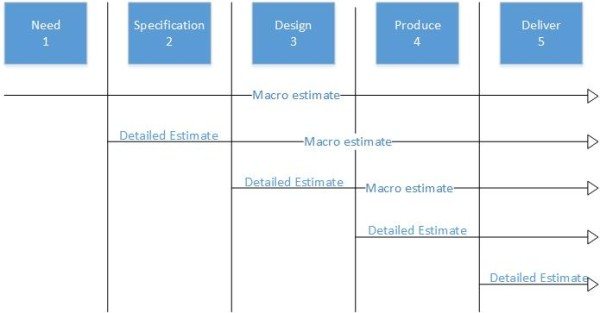Since estimating efforts cost money, the time and detail devoted to bottom up estimates is an important decision. Yet, when estimating is considered, you as a project manager may hear statements such as these:
- Rough order of magnitude is good enough. Spending time on detailed estimating wastes money.
- Time is everything; our survival depends on getting there first! Time and cost accuracy is not an issue.
- The project is internal. We don’t need to worry about cost.
- The project is so small, we don’t need to bother with estimates, Just do it.
- We were burned once. I want a detailed estimates of every task by the people responsible.
However, there are sound reasons for using top down or bottom up estimates
Bottom Up Estimates, Overview
Bottom up estimates at the work package level can serve as a check on cost elements in the WBS by rolling up the work packages and associated cost accounts to major deliverables. Similarly, resource requirements can be checked. Later, the time resource, and cost estimates from the work packages can be consolidated into time-phased networks, resource schedules, and budgets that are used for control.
The bottom up estimates also provides the customer with an opportunity to compare the low-cost, efficient method approach with any imposed restrictions.
For example, if the project completion duration is imposed at two years and your bottom-up analysis tells you the project will take two and one-half years, the client can now consider the trade-off of the low-cost method versus compressing the project to two years—or in rare cases canceling the project. Similar trade-offs can be compared for different levels of resources or increases in technical performance.
The assumption is any movement away from the low-cost, efficient method will increase costs—e.g., overtime. The preferred approach in defining the project is to make rough top-down estimates, develop the WBS/OBS, make bottom up estimates, develop schedules and budgets, and reconcile differences between top down and bottom up estimates. Hopefully, these steps will be done before final negotiation with either an internal or external customer.
In conclusion, the ideal approach is for the project manager to allow enough time for both the top down and bottom up estimates to be worked out so a complete plan based on reliable estimates can be offered to the customer.
In this way false expectations are minimized for all stakeholders and negotiation is reduced.
Bottom Up Estimates, Most Used Methods
Template Methods
If the project is similar to past projects, the costs from past projects can be used as a starting point for the new project. Differences in the new project can be noted and past times and costs adjusted to reflect these differences.
For example, a ship repair dry-dock firm has a set of standard repair projects (i.e. templates for overhaul, electrical, mechanical) that are used as starting points for estimating the cost and duration of any new project. Differences from the appropriate standardized project are noted (for times, costs, and resources) and changes made.
This approach enables the firm to develop a potential schedule, estimate costs, and develop a budget in a very short time span. Development or such templates in a database can quickly reduce estimate errors.
Parametric Procedures Applied to Specific Tasks
Just as parametric techniques such as cost per square foot can be the source of top-down estimates. the same technique can be applied to specific tasks.
For example, as part of an MS Office conversion project, 36 different computer workstations needed to be converted. Based on past conversion projects, the project manager determined that on average one person could convert three workstations per day. Therefore the task of converting the 36 workstations would take three technicians four days.
Similarly, to estimate the wallpapering allowance on a house remodel. the contractor figured a cost of $5 per square yard of wallpaper and $2 per yard to install it for a total cost of $7. By measuring the length and height of all the walls she was able to calculate the total area in square yards and multiply it by $7.
Range Estimating
When do you use range estimating?
Range estimating works best when work packages have significant uncertainty associated with the time or cost to complete. If the work package is routine and carries little uncertainty, using a person most familiar with the work package is usually the best approach. They know from experience or know where to find the information to estimate work package durations and costs.
However, when work packages have significant uncertainty associated with the time or cost to complete, it is a prudent policy to require three time estimates—low, average, and high (borrowed off of PERT methodology that uses probability distributions). The low to high give a range within which the average estimate will fall. Determining the low and high estimates for the activity is influenced by factors such as complexity, technology, newness, familiarity.
How do you get the estimates?
Since range estimating works best for work packages that have significant uncertainty, having a group determine the low, average, and high cost or duration gives best results. Group estimating tends to refine extremes by bringing more evaluative judgments to the estimate and potential risks. The judgment of others in a group helps to moderate extreme perceived risks associated with a time or cost estimate. Involving others in making activity estimates gains buy in and credibility to the estimate.
How do you use the estimate?
Group range estimating gives the project manager and owner an opportunity to assess the confidence associated with project times (and/or costs). The approach helps to reduce surprises as the project progresses. The range estimating method also provides a basis for assessing risk, managing resources, and determining the project contingency fund.
Range estimating is popular in software and new product projects where up-front requirements are fuzzy and not well known. Group range estimating is often used with phase estimating, which is discussed next.
A Hybrid: Phase Estimating
This approach begins with a top-down estimate for the project and then refines estimates for phases of the project as it is implemented. Some projects by their nature cannot be rigorously defined because of the uncertainty of design or the final product. Although rare, such projects do exist. These projects are often found in aerospace projects, IT projects, new technology projects, and construction projects where design is incomplete. In these projects, phase or life-cycle estimating is frequently used.
Phase estimating is used when an unusual amount of uncertainty surrounds a project and it is impractical to estimate times and costs for the entire project. Phase estimating uses a two-estimate system over the life of the project. A detailed estimate is developed for the immediate phase and a macro estimate is made for the remaining phases of the project.
The figure below depicts the phases of a project and the progression of estimates over its life.
 For example, when the project need is determined, a macro estimate of the project cost and duration is made so analysis and decisions can be made. Simultaneously a detailed estimate is made for deriving project specifications and a macro estimate for the remainder of the project.
For example, when the project need is determined, a macro estimate of the project cost and duration is made so analysis and decisions can be made. Simultaneously a detailed estimate is made for deriving project specifications and a macro estimate for the remainder of the project.
As the project progresses and specifications are solidified, a detailed estimate for design is made and a macro estimate for the remainder of the project is computed. Clearly, as the project progresses through its life cycle and more information is available, the reliability of the estimates should be improving.
Phase estimating is preferred by those working on projects where the final product is not known and the uncertainty is very large—for example, the integration of wireless phones and computers. The commitment to cost and schedule is only necessary over the next phase of the project and commitment to unrealistic future schedules and costs based on poor information is avoided.
Conclusion
This progressive macro/micro method provides a stronger basis for using schedule and cost estimates to manage progress during the next phase.
Unfortunately your customer—internal or external—will want an accurate estimate of schedule and cost the moment the decision is made to implement the project. Additionally, the customer who is paying for the project often perceives phase estimating as a blank check because costs and schedules are not firm over most of the project life cycle. Even though the reasons for phase estimating are sound and legitimate, most customers have to be sold on its legitimacy.
A major advantage for the customer is the opportunity to change features, re-evaluate, or even cancel the project in each new phase. In conclusion, phase estimating is very useful in projects that possess huge uncertainties concerning the final nature (shape, size, features) of the project.
See the figure below for a summary of the differences between top down and bottom up estimates.
 Obtaining accurate estimates is a challenge. Committed organizations accept the challenge of coming up with meaningful estimates and invest heavily in developing their capacity to do so. Accurate estimates reduce uncertainty and support a discipline for effectively managing projects.
Obtaining accurate estimates is a challenge. Committed organizations accept the challenge of coming up with meaningful estimates and invest heavily in developing their capacity to do so. Accurate estimates reduce uncertainty and support a discipline for effectively managing projects.
